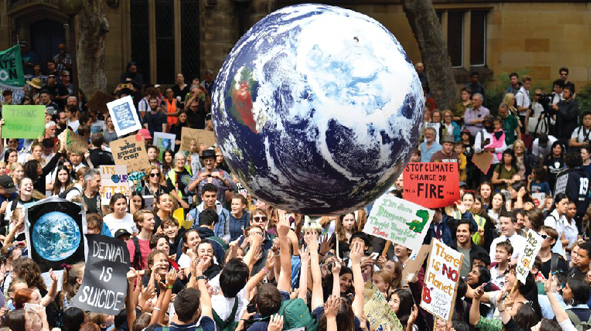Fast Fashion & Environmental Crisis

Did you notice how fashion brands’ showrooms change their window display with newly designed clothes? It may increase your interest in having a look or trying some new product. You may think I am not going to buy it; I just want to try it. So you enter the shop and give it a try. When you see yourself in the trial room wearing these clothes, you are thinking ”ahaa Not bad”. The next thing you want to see is the price. It only costs $19.90. Eventually, you come out of the shop with several products which you never thought it necessary to buy. That’s how the early fashion industry tricked you into buying so many garments & you toss them in the bin after a few times of wearing them.
It has been a new craze in recent years to wear quick fashion. Fast fashion has altered the way people dress and perceive what constitutes fashionable attire. Clothing prices dropped, and shopping became an enjoyable pastime. Consumer purchases at fast fashion outlets are the focus of this article. Research studies, case studies, and secondary data are analyzed, abstracted, synthesized, deduced by means of comparison, described and specified by the authors in their discussion of the fast fashion issue. Consumer purchases have a significant influence on economics, according to the authors, since, as we discovered, fast fashion is becoming increasingly popular in brick-and-mortar and online retail. When asked, the majority of buyers stated that they couldn’t connect clothing’s apparent good quality with its actual poor degree of durability when they, bought it from a fast-fashion retailer. Causing a rise in consumer demand.
Fashion houses used to release collections twice a year, once in the spring and summer and once in the fall and winter. Fast fashion stores now provide 50-60 micro-seasons every year, rather than the traditional two. But, you could argue, who needs so many outfits? They won’t last long or fade after a few wears, which is why these companies are always launching new collections and consumers are always yearning for something new.
The fashion industry is the second most polluting industry in the world, also the second-largest consumer of water worldwide, and it produces 10% of the planet’s carbon emissions.the current report shows that 62 million metric tons of apparel were consumed globally and 57% of all discarded clothing ends up in the landfill. What causes this industry to be more damaging than ever before is fast-fashion? A cotton shirt, on the other hand, uses around 3,000 liters of water to be made, which is about 10,000 liters of water in total. Textile dyeing also necessitates the use of hazardous chemicals that wind up in our waters.
Synthetic materials are the main cause of plastic microfiber pollution. These synthetic materials make up around 35% of all micro-plastics. To further reduce costs, manufacturers use low-quality materials. For example, many of the fibers are polyester, a synthetic that emits considerably more CO2 than cotton. Also, plastic takes a long time to break down in the water. Plastic breaks down into a poisonous chemical that harms marine habitats. Plastic microfibers cannot be removed and enter the human food chain via aquatic life, creating several health issues. They reach our ocean via a variety of routes, most typically through our washing machines. Although the washing machine is clearly a need in our homes, it is best to wash full loads to save water.
More than 0.6 degrees Fahrenheit (0.33 degrees Celsius) has been added to the ocean’s upper 100 meters (328 feet) since 1969, according to NASA’s data. The Earth’s seas store 90% of the excess energy generated by the planet.
According to the UN Environment Program, toxic waste from textile dyeing is the second-largest polluter of freshwater in the world.Bleaching, softening, water-resistant/wrinkle-resistant clothes, and other chemical treatments are just a few of the options available to consumers today. An excessive amount of water and chemical waste is discharged into the nearby waters of rivers and lakes while using water and chemicals for clothing dying.The World Bank estimates that throughout the dyeing process, 72 potentially dangerous chemicals are released into nearby waterways. As a result, fashion firms and manufacturers are often left with minimal accountability for wastewater disposal.
Bangladesh, a significant producer of garments, has a serious problem with water contamination. Since Bangladesh is the second-largest exporter of clothes in the world, Bangladeshi clothing can be found at many stores across the United States and Europe. However, the country’s waterways have been polluted for years by garment manufacturers, textile mills, and dyeing facilities.
We Didn’t Expect Climate Change to Be Happening So Quickly. Climate experts have long predicted that global warming will lead to sweltering temperatures in many regions of the planet. When asked about the occurrence, Wehner remarked, “We said it’s nearly impossible without climate change.” Michael Wehner, an extreme weather expert at Lawrence Berkeley National Laboratory, described his reaction to the heat in an interview with National Geographic as “but I would have stated previously that is nearly impossible given climate change”. His work was part of a team that analyzed the heatwave and concluded that it wouldn’t have occurred if the Earth hadn’t been warming due to human activity.
The environment is a major worry for today’s youth. Younger generations are entering the job, consumer market, and voting booths with a desire to improve the world around them. It is important for them to know that the product they are purchasing does not affect the environment. However, Gen Z is demanding better products and corporations are understanding the consequences of their poor practices thanks to this generation’s need for better products. With the help of ethical materials and procedures such as those used by brands like as Adidas and Ralph Lauren as well as Bonobo and ZARA, fashion brands are attempting to ensure the sustainability of their supply chains. Environmental effect is measured and mitigated throughout the supply chain, making them a carbon-neutral enterprise.
Once again, we must determine whether or not the Earth’s well-being is more important than our personal fashion preferences. Now we need to decide, if we want to buy stylish clothes every week or whether it is sufficient to spend less in order to rescue Mother Earth.




Comment here